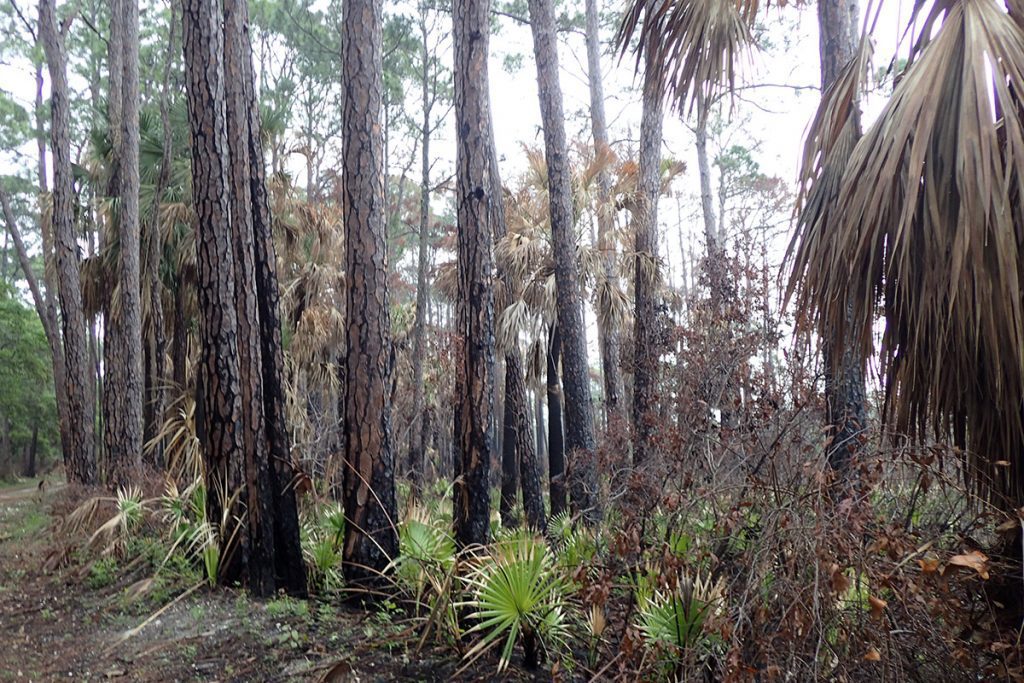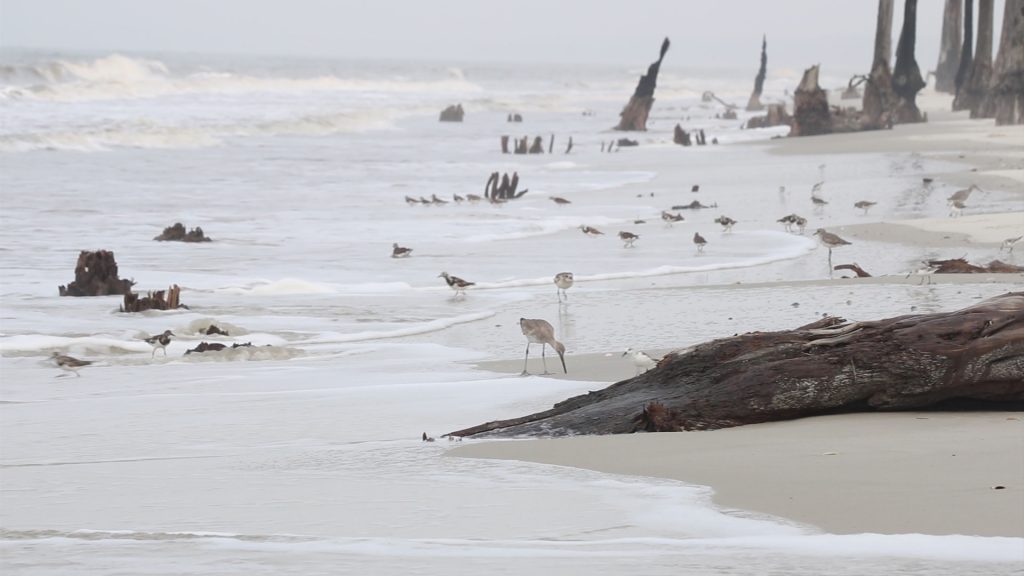The following video on the red wolves of Saint Vincent Island premiered at our screening of Red Wolf Revival at the Tallahassee Museum last Saturday. Next Thursday, April 27, at 8 pm ET Reel South: Red Wolf Revival will air on WFSU-TV. This award winning documentary looks at the wild population of red wolves, which lives in North Carolina.
Subscribe to receive more videos and articles about the natural wonders of our area.
REEL SOUTH is a co-production of UNC-TV, South Carolina ETV, and the Southern Documentary Fund (SDF) with major funding provided by the Corporation for Public Broadcasting.
If you missed it, make sure to check out our previous red wolf segment, on the breeding program at the Tallahassee Museum.
As in that previous segment, original music was composed for this video by Tracy Horenbein. Thanks to Tracy, and to Velma Frye and Becky Reardon for allowing us to use their song, Saint Vincent Island.
Rob Diaz de Villegas WFSU Media
Looking at it on a map, you can see how Saint Vincent Island is different than its neighbors. Think of Cape San Blas, St. George Island, and Dog Island as its siblings, all four birthed by the Apalachicola River. The others are skinny, while Saint Vincent, the oldest sibling, is, to put it nicely, thick. It’s not typical of barrier islands in Florida. However, this size makes it an ideal host for endangered red wolves.
It’s just after sunrise on Indian Pass, about four hundred yards from the island. There’s a small craft advisory today, but the water looks calm enough and we don’t have far to peddle (that’s right- peddle, not paddle). Our guide for today, Robin Vroegop, thinks if we can get back on the water by 12:30, we’ll avoid the forecasted thunderstorms and rough water.
Robin and her husband Mike are members of the Friends of Saint Vincent National Wildlife Refuge. Robin spent years volunteering with the island’s wolves, and is currently working on the sea turtle patrol. We won’t see any wolves today, but she’s taking us to a few spots that can teach us about their life on the island.
As we covered in our last post, the red wolf had been hunted to the brink of extinction by the 1970s. The US Fish and Wildlife Service started a breeding program to revive their numbers and eventually establish a self-sustaining wild population. Various zoos became breeding sites, like the subject of our last video, the Tallahassee Museum.
But while zoos can help bring new pups into the world, animals raised in captivity won’t have the skills to survive in the wild. That’s why the USFWS selected a few sites for captive red wolves to transition to wild living.
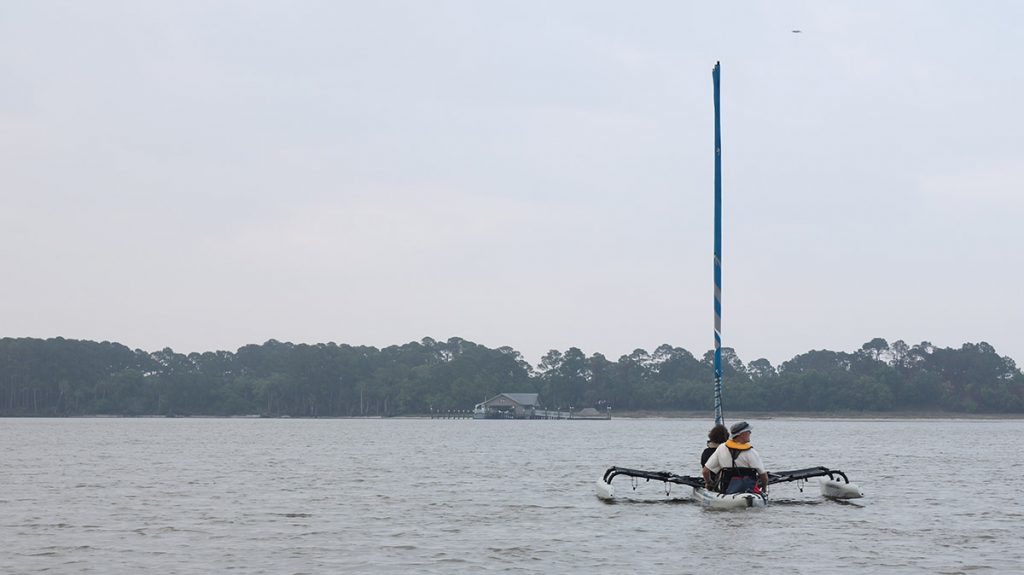
Robin and Mike took us to the island in two Hobies equipped for paddling, peddling, or sailing. We peddled across Indian Pass. The island is open to the public, but you can only get there by boat.
Saint Vincent Island | Red Wolf Island Propagation Site
Saint Vincent Island is home to one breeding pair of wolves. One male and one female are introduced onto the island, and the hope is that they’ll find each other and mate. It’s a wild setting, and on an island, they’re isolated from human habitation.
When a captive born wolf arrives on the island, it’s placed in an acclimation pen. Biologists gradually introduce meat from the island’s animals into its diet. When it’s finally released from the pen, it must be able to hunt for its meals.
An analysis of red wolf scat by a UF biologist showed that the wolves’ preferred food is feral hog. Unlike the larger grey wolf, they will also target smaller animals such as cotton rats. They’ll even eat berries. This diverse diet is made possible by Saint Vincent’s varied habitats.
When we first get to the island, we are greeted by charred pine bark and the surprisingly fragrant scent of fresh roasted wood and pine needles. Like much of our area, native longleaf pine here was long ago clear cut and replaced with slash. Both species tolerate fire, and controlled burning opens up the understory for a high diversity of succulent plants. These plants, in turn, support a high diversity of animals.
When we reach the end of the road, we emerge onto a beach on the west side of the island. Here, we get a taste of why Saint Vincent Island is a National Wildlife Refuge. As one wave retreats, ruddy turnstones race to peck at wet sand before the next wave chases them back up the beach. Meanwhile, semipalmated sandpipers work the edge of the wettest sand.
These shorebirds have lost a significant amount of habitat along their migratory paths. The island’s miles of unspoiled beach are critical to these and many other species.
Dune Ridges and Freshwater Lakes | Exploring a Red Wolf Habitat
I’m told that if you visit the beach before the tide comes in, there are places where you might see red wolf prints along the water’s edge. But while the wolves might enjoy some sand in their paws, it’s the interior of the island that makes Saint Vincent a suitable home.
“The unique thing about Saint Vincent Island,” Robin tells us, “is we have five freshwater lakes.” Those skinnier barrier islands, like St. George, don’t have enough interior for lakes and ponds. They also don’t have the topography.
Last summer, we visited the island with Susan Cerulean and Dr. Jeff Chanton. They explained how three or four thousand years ago, sediments from the Appalachian Mountains made their way down the Apalachicola River and into Apalachicola Bay. Over the course of hundreds of years, the sediments formed a succession of ridges that became Saint Vincent Island.
This created a terrain of alternating high and low areas. The higher areas became fire dependent pine uplands. The lower areas collected rain water and became ponds and freshwater marshes.
“The red wolves, for sure, they’re mammals,” Robin says. “They’re going to have… the needs that we need: fresh water, shelter, cover, food sources. Which, that means, their food sources normally require fresh water sources.”
These ponds support alligators, wading birds (like the little blue heron you see at 3:03), and waterfowl.
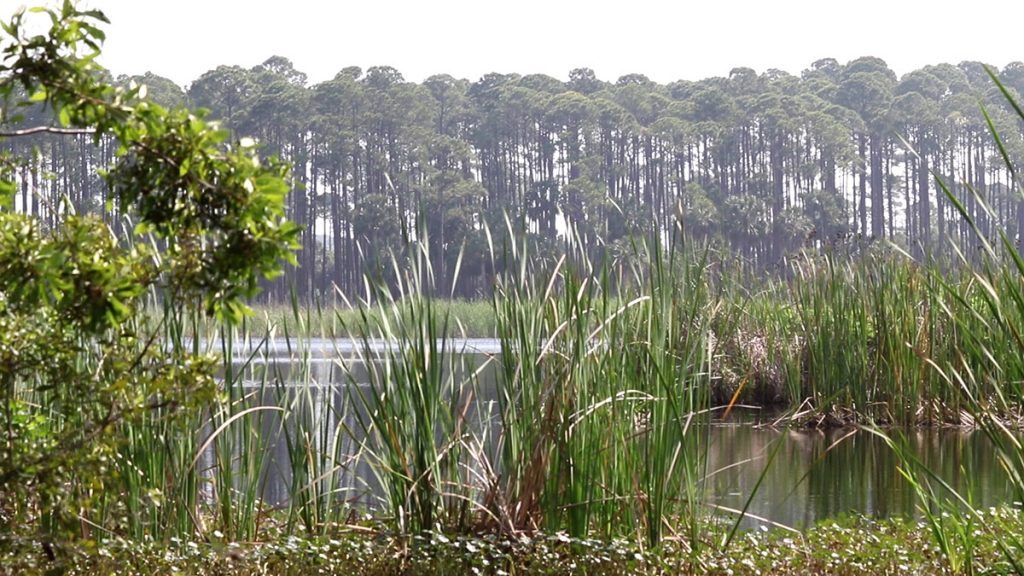
Oyster Pond on Saint Vincent Island. The tree line on the opposite shore is one of the island’s ridges. The pond formed between that ridge and the one on which we stood to take the photo.
Testing Survival Instincts During Hurricane Dennis
Fresh water for drinking, abundant prey animals, and space to roam- the island is well set up for red wolves. But there’s more to survival than the right habitat. We saw that when covering another reintroduction program run by the US Fish and Wildlife Service.
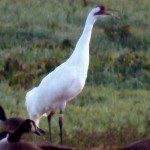 Last year we went behind the scenes at the St. Marks National Wildlife Refuge whooping crane pen. Those birds were captive raised and guided by ultralight planes along what had historically been their migration path. When the cranes returned to their nesting grounds in Wisconsin, though, they seemed to lack the instincts to protect their wild born offspring from black flies. Their fledgelings weren’t surviving. And if animals can’t raise young without human assistance, they can’t become self-sustaining. Over the past year, USFWS eliminated rearing cranes in captivity as well as ultralight guided migrations in an attempt to correct the problem.
Last year we went behind the scenes at the St. Marks National Wildlife Refuge whooping crane pen. Those birds were captive raised and guided by ultralight planes along what had historically been their migration path. When the cranes returned to their nesting grounds in Wisconsin, though, they seemed to lack the instincts to protect their wild born offspring from black flies. Their fledgelings weren’t surviving. And if animals can’t raise young without human assistance, they can’t become self-sustaining. Over the past year, USFWS eliminated rearing cranes in captivity as well as ultralight guided migrations in an attempt to correct the problem.
In 2005, the island’s female red wolf faced the greatest test of her parenting instincts. Hurricane Dennis slammed the barrier island with what Robin Vroegop estimates was a twelve foot storm surge. Saint Vincent’s topography meant there was severe flooding. Refuge managers worried over the fate of the island’s first litter of pups in some years.
The Refuge biologist was out of town during the hurricane. Robin had been volunteering with the wolves, and was called to accompany the Refuge managers in a search for the wolves. Her job was to listen for a signal from the mother wolf’s radio collar.
“We really were expecting to hear what we call a mortality signal.” Robin recalls. “That’s when you have a solid beep- instead of the beep-beep, it’s just beeeeeep.”
They made their way the best they could on the island’s roads, eventually reaching its highest ridge. Robin chokes up as she remembers what happened next.
“I still get upset about it, every time I talk about it! I was so happy to hear that signal, I just could not believe that she could have had the intelligence and the experience to know where to take those puppies, to the highest point on the island.”
Red Wolf 982 | Red Wolf Super Mom
“Red Wolf 982, who brought her four pups through the hurricane… She went on to produce multiple litters over a number of years.” Robin remembers. “She was renowned in the red wolf recovery program.”
982 was reared on Saint Vincent Island before being relocated to Alligator River National Wildlife Refuge. The wild population of wolves lives in a five county area of North Carolina centered on Alligator River. Since the entire red wolf population is descended from 14 founder animals, males and females are shuffled to different breeding sites based on their genetic profile. The idea is to minimize inbreeding and promote the greatest possible genetic diversity.
She returned to Saint Vincent Island to be its breeding female. The 2005 litter she protected from the storm was her first. She produced litters until she was eleven years old.
“I was told by the biologists up there (Alligator River) that the average life expectancy in the wild was six years.” Robin says. “So she was a mature momma!”
In my research for this piece, I came across something called the Red Wolf Studbook. It lists every wolf born in the breeding program, and tracks their movement between breeding sites and the wild population in North Carolina. 982 was born in May of 1998 and died in September of 2009. Like many pups born on island propagation sites, she was transferred to North Carolina when she reached 18 months of age. She returned a year later to be the island’s breeding female.
If you scan the document (search for 982), you can also see when each of her pups were born, and where they ended up within the system.
Predators and Ecological Balance
On many of our adventures, we travel through land that is in the process of being restored. We see a lot forest being returned to native longleaf habitat. We’ve visited coastal sites where salt marsh and oyster reef habitats were restored. Animals such as red cockaded woodpeckers, gopher tortoises, and striped newts receive assistance and protection from humans in order to help their numbers. People want to return our ecosystems to their historic biodiversity.
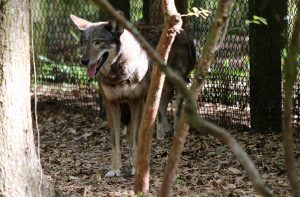 Usually missing in this quest to return the land to “what it once was” are apex predators. When Europeans first trekked through north Florida, it was home to panthers and red wolves. Predators maintain balance in an ecosystem by controlling the numbers of their prey animals, such as deer, hogs, and so on.
Usually missing in this quest to return the land to “what it once was” are apex predators. When Europeans first trekked through north Florida, it was home to panthers and red wolves. Predators maintain balance in an ecosystem by controlling the numbers of their prey animals, such as deer, hogs, and so on.
“That’s a key function of the predators is to keep populations in balance.” says Mike Jones, Animal Curator at the Tallahassee Museum. “When you get overpopulation, you’ll get diseases springing up. Like out west they got a thing out west called chronic wasting disease. It’s like mad cow disease.” CWD affects wolf prey species such as deer, elk, and moose.
As things warm up, we start to worry about ticks and tick borne illnesses. Deer ticks carry Lyme disease, and lone star ticks carry Southern Tick Associated Rash Illness, which is similar to Lyme and more common in our area. Both species feed on deer blood, and there is evidence that reducing deer populations would reduce the number of ticks carrying Lyme.
Aside from disease, losing an apex predator opens a space atop the food web for a nonnative predator.
“When you start taking out a whole species of animal,” Mike says ,”it’s going to leave a void and whatever niche they filled is not going to be occupied.” In our area, coyotes have come from out west to fill that role.
“Coyotes… evolved for a different habitat,” Robin says. “They tolerate human habitation greater than the red wolves. All of a sudden we’ll have coyotes eating our pets, for example.
“If you have an intact ecosystem, with the animals that evolved there, it’s going to be operational.”
For a more in depth look on the effects of a predator on an ecosystem, you might want to check out our In the Grass, On the Reef project (2010-2014). Dr. David Kimbro and Dr. Randall Hughes looked at how a top predator could affect the oyster reef ecosystem by devouring oyster consumers- and scaring them. Dr. Kimbro also explored this ecology of fear in seagrass beds, looking at how the horse conch affected everything from snails to clams to the nutrients that fed the seagrass itself. It’s not wolves and panthers, but there are similar dynamics at play. It’s not entirely dissimilar from grey wolves and their effect on ecosystems in Yellowstone National Park.
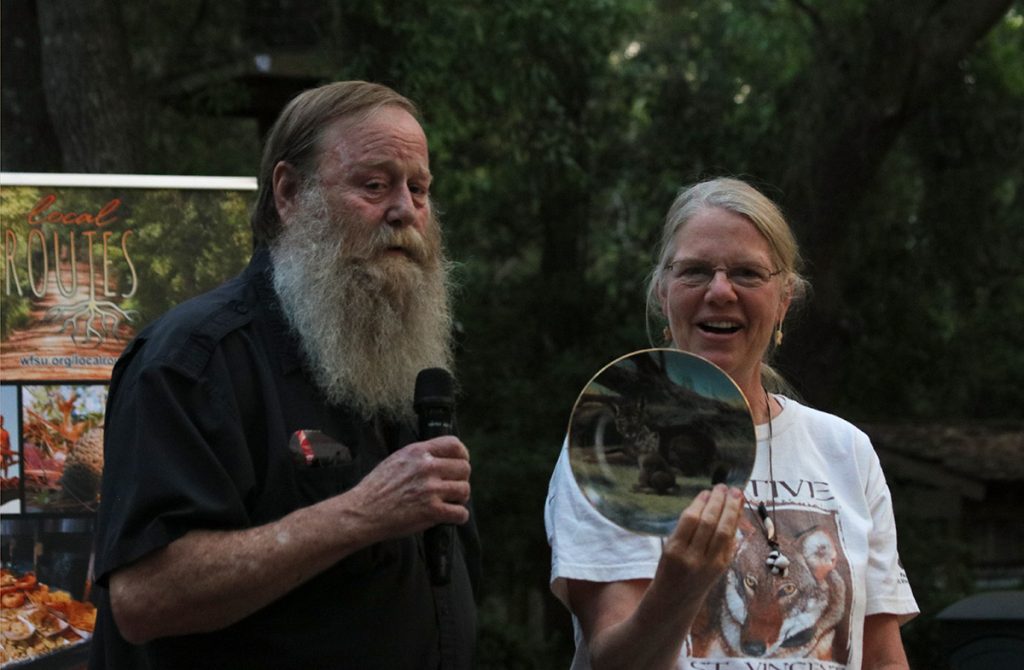
Robin Vroegop presents Mike Jones with a red wolf plate at the Red Wolf Revival screening at the Tallahassee Museum last Saturday, April 15. Robin thanked Mike for all of his help with Saint Vincent Island’s red wolves over the years.
Robin’s Environmental Volunteering Message
“I’ve been volunteering here since 2004 in a lot of different capacities, whatever’s needed. We always need volunteers, we always need help!” Robin laughs. “This has without question, hands down, been the most rewarding experience.
“They’ve allowed me to do it long enough to become familiar enough with the island that I always feel that I’m learning every time I come here.
“So, I would just encourage people- it doesn’t have to be a refuge- get involved in the environment. It can be a little trail in the neighborhood. Get involved with that and you’re going to learn stuff. If you walk that trail every day… you’re going to end up learning a lot about the environment and you’ll end up enriching your life by it.”
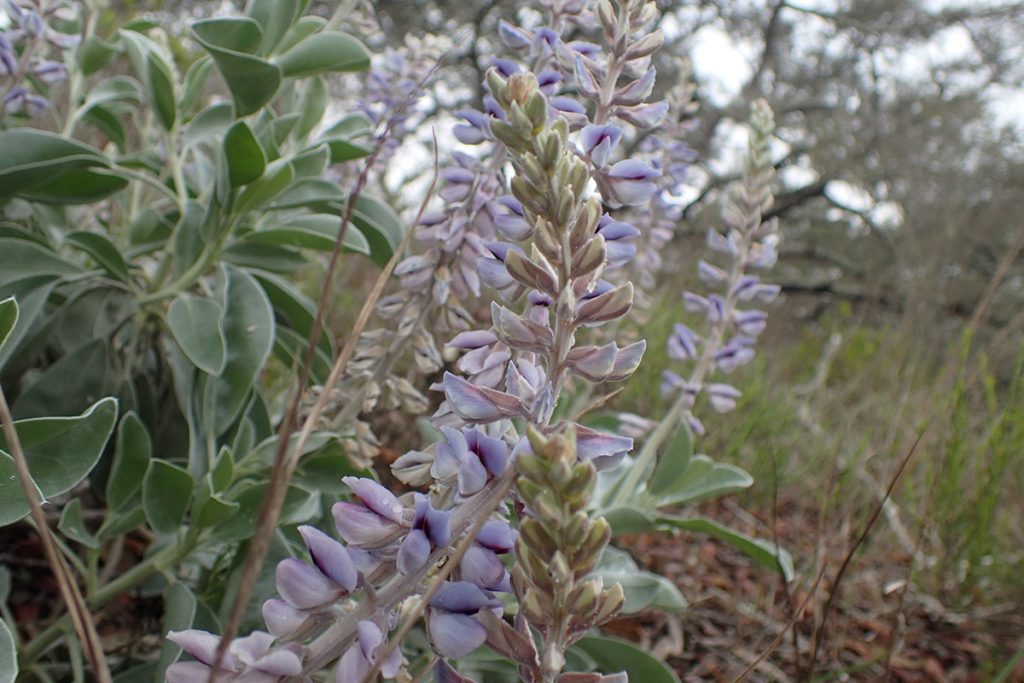
Gulf Coast Lupine, Lupinus westianus, flowering on Saint Vincent Island. The name lupine derives from the Latin lupus, or wolf.

